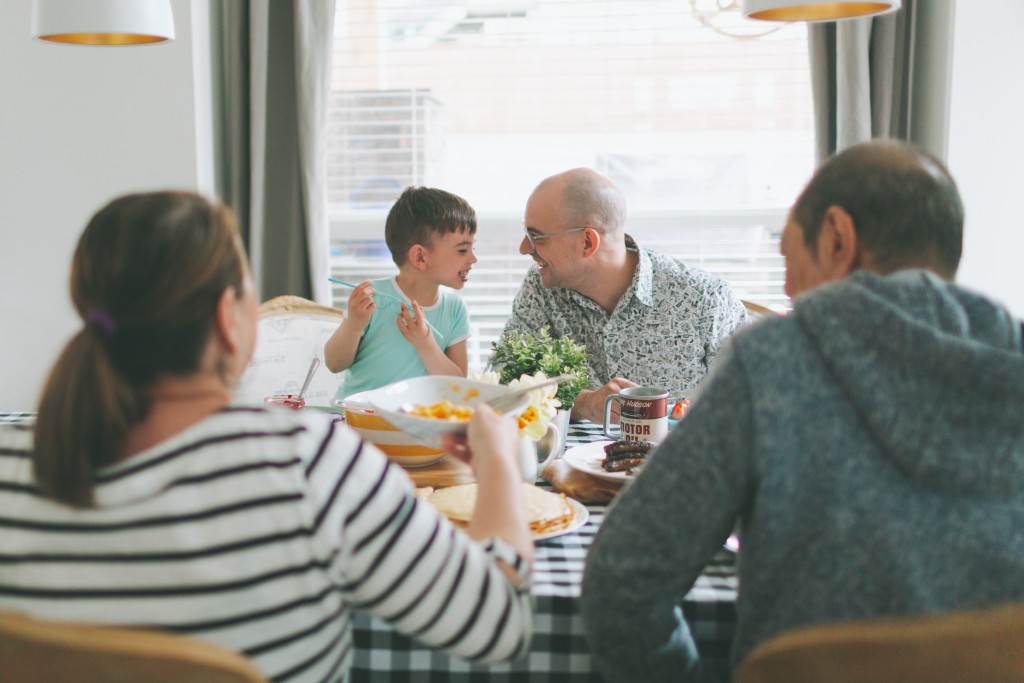
You’re watching your weight, trapped at home by COVID-19 and mere steps from your well-stocked kitchen. You ate breakfast and a mid-morning snack, and it’s not yet lunchtime.
Tantalizing thoughts of leftover lasagna in your fridge torment you. It seems easier to give in than to resist.
Keeley Pratt, associate professor of human development and family science, is dedicated to helping people lose those lockdown pounds through medical family therapy.
“During COVID-19, managing healthy behaviors can be harder,” she said. “It’s more challenging to avoid grazing and to give yourself the space to make healthy decisions. Life can be chaotic with many people in the home, and when life is chaotic, it’s harder to make healthy decisions.”
Pratt and her graduate therapist trainees offer individual consultations, family therapy and groups about changing individual and family health behaviors and routines. Their service is through the Comprehensive Weight Management, Metabolic and Bariatric Surgery Program at The Ohio State University Wexner Medical Center.
“We use family systems theory to see the interconnected elements of a family, like family routines, patterns, communication and dynamics,” she said. “We focus on how the family can support that person.”

Three challenges of behavior change and losing weight
Adults face three challenges that typically interfere with healthy behaviors and weight loss.
- Some struggle with interpersonal relationships, such as with a romantic partner, spouse or child. This can increase stress when trying to change individual or family behaviors. Support for change may be lacking.
- Others may have undiagnosed or untreated mental health needs that come to light when trying to change long-term behaviors and routines. Often these need to be treated simultaneously or even before one can change existing health behaviors.
- After initial success with behavior change and weight loss, maintenance can be challenging. Choosing to eat healthier and exercise does not always come easily. Over time, individuals and families may return to prior ways of functioning.
COVID magnifying stressors
Stressors that people had before COVID now are magnified. “Interpersonal challenges become more stressful if you are restricted in your ability to leave home,” Pratt said. “Family members who may not have had good relationships or communication pre-pandemic are now together all the time during COVID.”
Common, harmful outlets for stress are eating unhealthy or low-nutrient dense foods, and excessive sleep or screen time.
“Prior to the pandemic, we often worked with patients who were having success in making behavior changes and subsequent weight loss,” Pratt said. But with the pandemic, “a lot of our patients have either plateaued or reversed directions and struggle to maintain prior healthy behaviors and routines.”
Before the pandemic, a main challenge was planning for social events that revolved around buffet-style and often unhealthy food. Now, the challenge is how to deal with food being constantly available.

Finding strategies that work
Pratt and the student therapists help patients explore a variety of strategies.
Assess the home setup. What is the home environment like for the family, and how has it changed over the pandemic? Consider these questions:
- Are one or multiple adults working from home now?
- Are children at home doing remote or hybrid school?
- How is space allocated for work/school?
- How have boundaries around family interactions and routines changed?
Having everyone at home often means common and personal spaces are taken over. The living room or kitchen may be the only unoccupied rooms. Yet, “those are the most tempting places, because the kitchen is where the food is kept,” Pratt said. “The living room is often where the television is. It’s tempting to be sedentary, watch television and mindlessly graze on food.”
Try a structured approach to interacting with your environment.
- Create a list or schedule of personal or family eating times and activity-related goals.
- To achieve these goals, plan meals and snacks for the day and opportunities for activity.
- Schedule screen time and length, intentionally picking shows instead of engaging mindlessly.
- Place the schedule in a visible location, such as on the refrigerator or kitchen counter, as a reminder of the goals.

Consider “thought stopping.” If you go to the refrigerator out of habit and are not actually hungry, tell yourself to stop, Pratt said. Imagine a stop sign or put a note on your refrigerator that says, “stop.” This slows you down, allowing you to ask yourself, “What’s going on with me emotionally? Am I anxious? Am I nervous? Am I bored? Am I truly hungry?”
Reaching for food or drinks when you’re bored can become habitual. It stimulates the senses and gives you something to do with your hands. Pratt recommends asking, “What can I do to deal with whatever emotion I am experiencing instead of eating?”
Consider practicing mindfulness, distraction, drinking a glass of water first, calling a friend or going for a walk. Then see if you’re still hungry.
Assess your level of hunger. Ask yourself where your hunger level is on a scale from 1 to 5, with 1 being full and 5 being very hungry. Decide in advance which level merits eating, likely a 3 to 5. Determine if you can wait until the next meal. If you decide to eat, choose a healthy, nutrient-dense food.
“Many of us were never taught as children what it means to feel full or hungry,” Pratt said. If children have access to food whenever they want it and no rules or structure around eating, they may not learn what hunger and fullness physiologically feel like.
Conversely, if a household is food insecure, children might eat as much as possible when food is available, fearing that not enough food will be available later. Recognizing fullness becomes less important.
“We see high associations between food insecurity and obesity,” Pratt said. “In the weight management and weight loss surgery population at Ohio State, more than 30% have household food insecurity.
“So part of the challenge is to help children and adults understand, ‘Here's what my body feels like when I’m hungry … and when I’m full,’” Pratt said. “If we learn that from an early age, great, but it’s not uncommon for adults to have to relearn this after developing unhealthy habits and routines.”

Engage family members to help with behavior change. Family support of the patient is important but complex, Pratt said. She and her students encourage patients to bring family members to appointments and invite them to participate in goals and household changes with them.
“This is an opportunity to engage the partner, the child and other family members in the patient’s process of making healthy decisions and working toward their goals,” she said. “We help the parent communicate with children about their goals and how children can support, participate and engage.”
If a child wants a snack every afternoon, consider healthy options to make together. If the child wants something not part of the parent’s dietary plan, ask them to be independent and make it themselves.
A pandemic benefit: By delivering sessions virtually, therapists can engage the whole family more easily and see the environment in which the patient and family interact.
“We dialogue with patients about how to navigate those conversations,” Pratt said. “We encourage them to explain what they’re trying to do, what it will look like and how family members can help or support them in making healthier choices.”
Emphasize behavior and health status, not weight, during discussions. “Parental obesity status is the strongest risk factor for children to develop obesity,” Pratt said. “When a parent enters weight management or has bariatric surgery, their child observes and hears how they talk about their weight, bodies and health behaviors. It offers an excellent opportunity to discuss health and establishing healthy habits.”
Few parents, however, report communicating their goals and program participation to their children.
The best approach is to focus on health rather than body shape, size or weight. This is especially important for older children and children who are overweight or obese, because parents engage them in conversations more.
Seek exercise solutions. If you live in an area safe for outdoor activity, Pratt recommends walking as a family, or finding fun and creative ways to exercise or play an active family game in your yard or driveway.
Inside, Pratt suggests using resistance bands, exercise balls or light free weights. “Download free exercise, fitness or dance videos,” she said. “We have to get really creative about fitness, particularly with not knowing what safety protocols will be for gyms this winter with COVID-19.”
Address romantic relationships early. Because a partner’s support is critical, Pratt and her students counsel about how to communicate goals, request and provide support, and address underlying issues in romantic relationships. “Male partners, for example, tend to become more insecure after their female partners have bariatric surgery and become more confident and social,” she said.
Alternatively, a spouse might find their partner more attractive as weight loss progresses. And young children might find parents more willing to engage in fun activities as they become more conditioned for activity.

Eat family meals together. Pratt and colleagues conducted the first study to examine the family meal practices of adult patients participating in weight loss management or weight loss surgery.
They found that parents who had weight-loss surgery and reported good family communication and support were more likely to eat dinner and breakfast as a family.
However, if communication was challenging, a family was more likely to eat evening meals in front of the television.
“The ultimate goal is for the whole family to decide to make a change,” Pratt said.
“The onus of behavior is on everyone.”

Keeley Pratt also has an appointment with Ohio State’s Departments of Surgery and Pediatrics. She and her students recently began offering weight management services at the Wexner Medical Center’s Department of Family Practice. She also offers tips for healthy eating behavior during the pandemic holidays.




